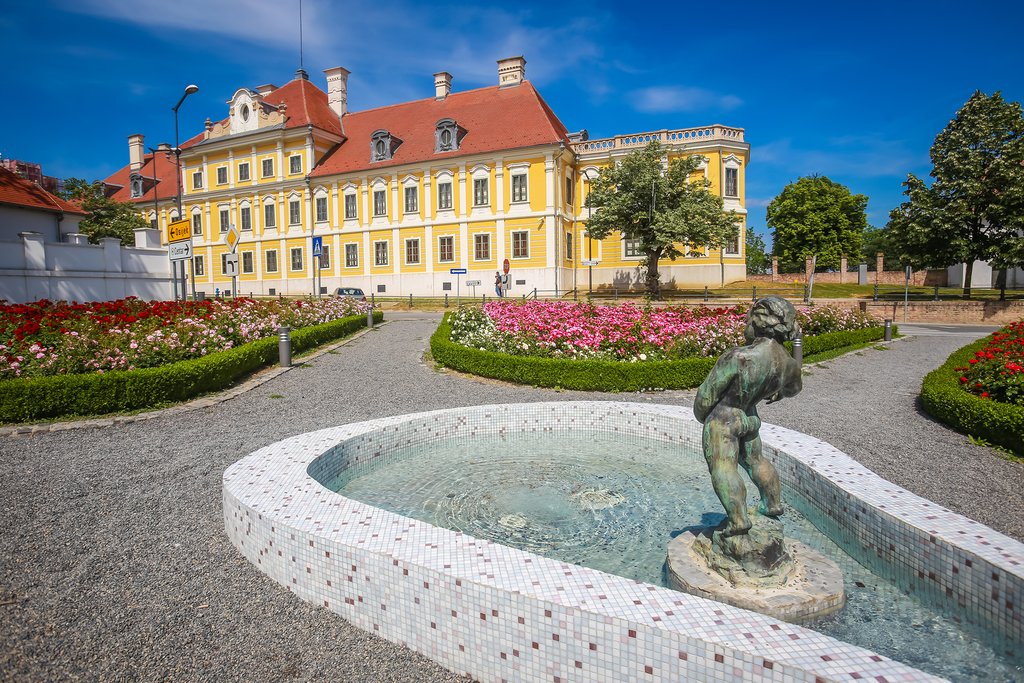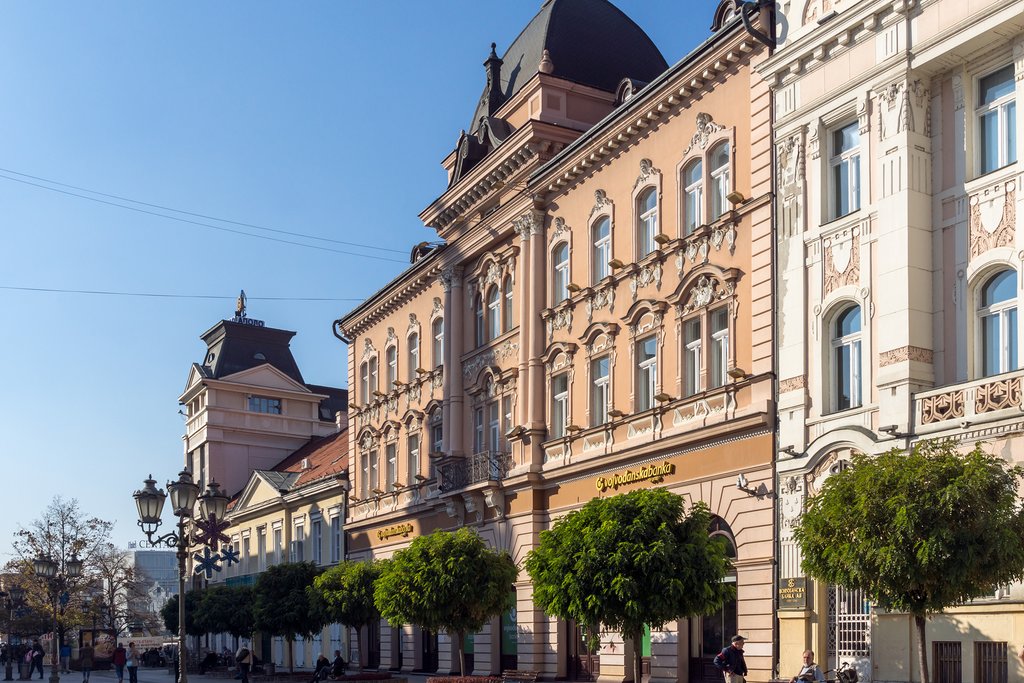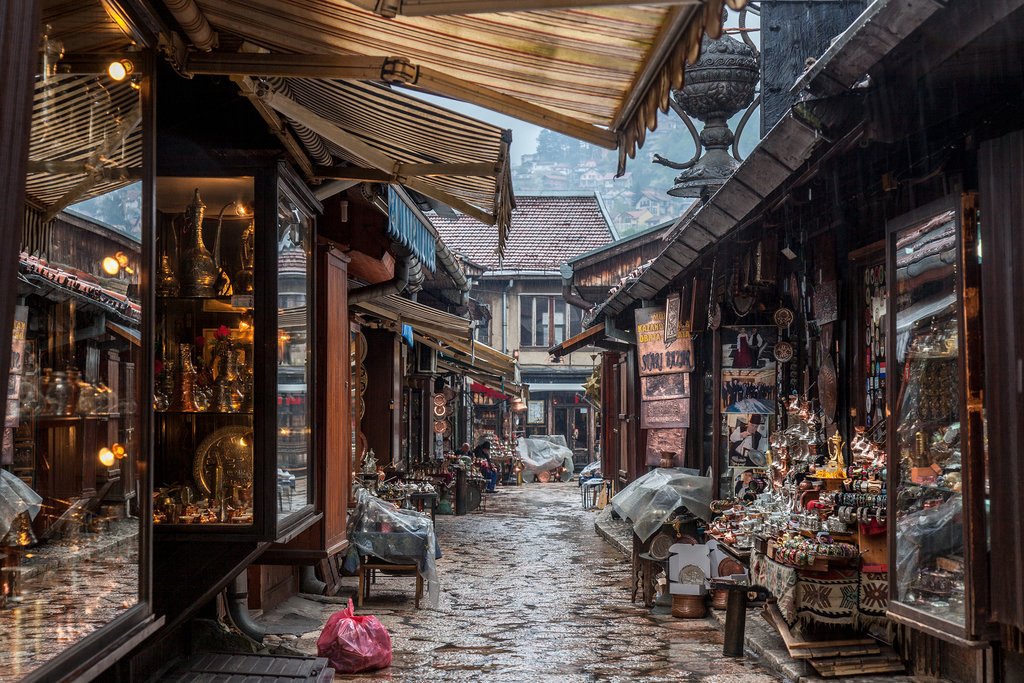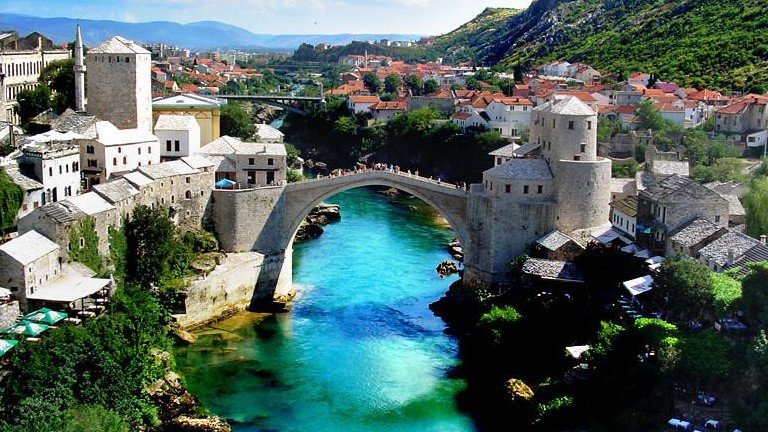Highlights
- Discover Ljubljana's dragons as you walk through one of Europe's greenest cities
- Stroll through leafy green parks, like Maksimir, in Croatia's capital, Zagreb
- Take in the sunset from atop the Belgrade Fortress in Kalemegdan Park
- Explore the narrow, merchant streets of Baščaršija, Sarajevo's historic quarter
- Wander through King's Park to Podgorica's charming ancient Roman bridge
Brief Itinerary
| Day | Highlights | Overnight |
|---|---|---|
| Day 1 | Arrive in Ljubljana | Ljubljana |
| Day 2 | Explore Ljubljana, Onward to Zagreb | Zagreb |
| Day 3 | Morning Tour of Zagreb, Afternoon Day Trip to Varaždin | Zagreb |
| Day 4 | Zagreb to Belgrade, Stopping in Osijek and Vukovar | Belgrade |
| Day 5 | Explore Belgrade, Afternoon Day Trip to Novi Sad | Belgrade |
| Day 6 | Belgrade to Sarajevo, Walking Tour of Sarajevo | sarajevo |
| Day 7 | Day Trip from Sarajevo to Mostar | sarajevo |
| Day 8 | Sarajevo to Podgorica, Stopping in Nikšić | Podgorica |
| Day 9 | Podgorica to Dubrovnik, Stopping at Budva and Kotor | Dubrovnik |
| Day 10 | Walking Tour of Dubrovnik | Dubrovnik |
| Day 11 | Depart Dubrovnik |
Detailed Itinerary
Day 1: Arrive in Ljubljana

Welcome to Slovenia! Upon arrival at the Ljubljana Jože Pučnik Airport, you'll transfer to your hotel in the capital, just a 30-minute drive away.
Afterward, explore the lively city center and saunter down the main street along the banks of the Ljubljanica river, stopping in whatever small boutique, outdoor café, or wine-bar terrace that strikes your fancy all the while breathing in the fresh air of one of the continent's greenest cities. A classic European castle, parks, and churches are all on offer as you wind your way around by foot or bicycle.
You'll notice the legacy of modern architect Jože Plečnik around the city at worthwhile stops such as the National Library, Central Market, Triple Bridge, and Plečnik's own home-turned-museum, all under the watchful eyes of the city's many signature dragons. The Central Market is also a key site for sampling local cuisine at its many stalls.
Day 2: Explore Ljubljana, Onward to Zagreb

Spend the morning exploring Ljubljana on your own. If you want to learn more about the history and culture of the city, join a guided walking or biking tour. For lunch, try one of the many set menus that restaurants offer, or head to the Central Market to peruse its food stalls before making the trip east to Zagreb, Croatia's dynamic capital.
A gem of a European city, Zagreb is at once historic and new. It's filled with leafy green parks and gothic/neo-renaissance buildings, yet there are also modern shopping complexes, outdoor malls, and endless dining and drinking options. Consider heading out on a guided walking tour of the historic heart of the city. This involves walking from Ban Jelačić, the main square, to Zagreb's Upper Town and passing through local markets before reaching St. Mark's Square.
Alternatively, you can visit one of the many museums and art galleries, like the Homeland War Museum, the Nikola Tesla Technical Museum, or the ever-popular Museum of Broken Hearts. Or stroll through the city center, enjoying 17th-century neo-baroque architecture found at Zagreb's Art Pavilion and Croatian National Theater. Zagreb also has a number of beautiful city parks which are great for exploring and people watching, especially in the late afternoon. Maksimir is a great option, with a variety of cafés nearby to pick up a coffee for your stroll.
Driving time (Ljubljana to Zagreb): 2 hours
Day 3: Morning Tour of Zagreb, Afternoon Day Trip to Varaždin

Chock-full of museums, great architecture, trendy neighborhoods, and nightlife, immerse yourself in Zagreb on a half-day walking tour this morning.
To begin the tour, meet your guide at the main square of Ban Jelačić and then wind your way through the network of small streets through the oldest part of Zagreb, Gornji Grad (Upper Town), an area that stretches between two hills: Kaptol and Gradec. You'll visit the Cathedral, Tkalčićeva Street, the Kamenita Vrata (Stone Gate), and St. Mark's Church with its famed multi-colored roof as well as learn why the Grič cannon fires from the Lotrščak Tower every day at noon.
Situated just north of Zagreb, lies the Zagorje, a bucolic hilly region, dotted with Renaissance and medieval fortresses, numerous baroque castles, and family-run vineyards and farms. You'll head through the memorable landscape to explore Croatia's former capital, Varaždin. This wonderfully preserved town is known for its baroque and rococo architecture and is an example of how Croatia looked during the prosperous 17th century. A stroll through the old center of town reveals the former palaces of noble families, baroque façades, parks, and palaces, the Old Castle, and the historic feudal fort—the highlight of your visit.
After visiting Varaždin, enjoy a delicious meal of traditional specialties from the Zagorje region before returning to Zagreb in the early evening.
Driving time (Zagreb to Varaždin): 1-1.5 hours
Day 4: Zagreb to Belgrade, Stopping in Osijek and Vukovar

Get an early start today to make the drive east to your next capital city, Belgrade. Along the way, break up the journey with a stop in the often-overlooked Osijek. The largest city as well as the economic and cultural center of Croatia's far eastern region of Slavonia, Osijek's history as a multi-ethnic hub is evident in its food scene with some of the finest examples of Austro-Hungarian cuisine in the country. Sit down to a smoky, slow-cooked stew before exploring Tvrđa, the old town center and visiting the neo-Gothic Cathedral of St. Peter and Paul.
From there, you might like to stop in Vukovar. Seated at the confluence of the Vuka and the Danube, Vukovar once brimmed with elegant baroque mansions, art galleries, and museums though with the three-month siege of the city in 1991 and the subsequent Serbian occupation, much of its sophisticated charm is lost. With that said and a bit of imagination, you'll want to find your way to the 18th-century Eltz Castle (now a museum) and the parish Church of St. James (for views over the city and the Danube river) to imagine what it was once like.
Come the mid-afternoon, you'll cross the border into Serbia and continue east to Belgrade. The capital of Serbia, Belgrade rests where the Danube and Sava rivers meet and is one of Europe's oldest, as well as most happening cities. After settling into your accommodation, you'll want to get out and explore the city's eclectic heritage, chock-full of Habsburg, Ottoman, and communist-era influences. Head to Terazija, the central town square, for a host of things to do and architectural masterpieces to drool over, like the National Parliament.
Driving time (Zagreb to Osijek): 3 hours
Driving time (Osijek to Vukovar): 45 minutes
Driving time (Vukovar to Belgrade): 2 hours
Chat with a local specialist who can help organize your trip.
Day 5: Explore Belgrade, Afternoon Day Trip to Novi Sad

For a plethora of important monuments that span the last 2000 years, be sure to spend a little time this morning in Belgrade's centrally located park, Kalemegdan, before checking out its fortress complex—a great spot to overlook the city as well as take in a sunset.
When you're ready, you'll transfer north across the Danube to one of Serbia's more liberal cities, Novi Sad. Meaning "New Orchard," Novi Sad is small enough to navigate by foot and is home to pastel-colored Habsburg-era buildings, art galleries, pretty parks, café-lined streets, and bustling markets. Enjoy an afternoon of discovering Novi Sad's famous buildings, including the University, National Theater, and the country's most impressive monument, the 17th-century Petrovaradin Fortress.
Keeping a watchful eye over Novi Sad, the mighty citadel sits atop a 131-foot (40 m) volcanic slab earning its moniker, the "Gibraltar on the Danube." Tuck into a pre-fortress treat from bakery Multi Tarte as you work your way uphill to the castle where you can roam free or join a tour to discover the nearly 10 miles (16 km) of unlit (and eerie) underground tunnels. You'll return to Belgrade in the evening for dinner and possibly to catch that sunset from the Belgrade Fortress.
Driving time (Belgrade to Novi Sad): 1.5 hours
Day 6: Belgrade to Sarajevo, Walking Tour of Sarajevo

Following breakfast, you'll venture southwest to leave Serbia behind and cross the border into Bosnia and Herzegovina and to Sarajevo. One of the most culturally diverse cities in Europe, Bosnia and Herzegovina's capital city spent over 400 years under Turkish rule until the Austro-Hungarians arrived in the late nineteenth century. Fifty years later, the empire collapsed when Archduke Ferdinand was assassinated here, hastening the outbreak of the First World War.
After settling into your hotel, you'll join a comprehensive walking tour to piece together Sarajevo's complex and fascinating history as you take in the sights that showcase the city's unique link between the East and West. You'll stroll along the narrow, merchant streets of Baščaršija, the 15th-century historic quarter, visit Svrzo's House and Vijećnica (City Hall)—a site completely renovated after being destroyed in the 1992 Bosnian War—as well as discover Emperor's Mosque, the Princip Most (Latin Bridge), and Sahat Tower.
Driving time (Belgrade to Sarajevo): 4.5-5 hours
Day 7: Day Trip from Sarajevo to Mostar

This morning you'll make the scenic drive through the beautiful Neretva Valley to picturesque Mostar. A tourist's paradise, enjoy stunning panoramic views of the Neretva River from the minaret of the Koski Mehmed-Pasha Mosque, traipse along historic alleyways and paths of Old Town, once the center of the city's Islamic culture, and cross the painstakingly reconstructed medieval Stari Most (Old Bridge). The number of notable architectural landmarks combined with the relaxed and inviting atmosphere of the old city will leave you charmed.
Driving time (Sarajevo to Mostar): 2.5 hours
Day 8: Sarajevo to Podgorica, Stopping in Nikšić

Today, you'll cross the border into Montenegro and continue south to spend a couple of hours exploring the country's second-biggest city, Nikšić. Sitting at the foot of Trebjesa Hill within the Zeta river valley, Nikšić makes for a great pitstop. Head to Trg Slobode, the main square, and enjoy a Montenegrin lunch at a café, sipping on locally-brewed Nikšićko Pivo, while you take in the scene of passersby. Before setting off, you might like to take a look at the late 19th-century palace residence of King Nikola—and who the town was named after.
Come the early afternoon, travel further south to Montenegro's unpretentious capital of Podgorica, settling into your hotel before taking the rest of the afternoon to explore.
Podgorica has been through a lot; its history evident in the buildings leftover from every era, from the Romans to the Turks to the Austro-Hungarians. Start in Stara Varoš, the old Ottoman town south of the Ribnica river, at the blocky clock tower, once used to call Muslim worshippers to prayer. Wind your way through the maze of streets behind the clock for the 15th-century Starodoganjska Mosque and the more impressive Osmanagić Mosque. And be sure to check out the Ribnica fortress at the confluence of the Ribnica and Morača rivers.
If there's interest, you might also like to venture to the nearby Duklja archaeological site (less than 2 miles away) for ruins of the ancient Illyrian, Roman, and Byzantine city. In the evening, wander through the King's Park to the charming Roman Most na Skalinama (Old Ribinica River Bridge), followed by a filling meal at the atmospheric Pod Volat.
Driving time (Sarajevo to Nikšić): 3.5-4 hours
Driving time (Nikšić to Podgorica): 1 hour
Day 9: Podgorica to Dubrovnik, Stopping at Budva and Kotor

This morning, you'll make your way south toward the Adriatic Sea and to the popular summer resort town of Budva, the "Montenegrin Miami." Known for its sandy beaches and lively nightlife, Budva's medieval Stari Grad (Old Town) is also recognized for its rich cultural heritage, squares, churches, and Venetian stone walls that outline its romantic laneways. Enjoy a stroll along the Budva Riviera and take a quick dip if the mood should strike or tour the marbled streets of Stari Grad to the Citadela for striking views and the entry to the town walls.
You'll want to leave time for the scenic drive to Dubrovnik as well as a stop to visit another medieval coastal village, Kotor. This UNESCO World Heritage Site is built on a sloping mountain and abounds with Venetian palaces and Romanesque churches where you'll want to check out the Cathedral of St. Tryphon (Sveti Tripun)—a monument of Roman culture and one of the most recognizable symbols of the city. From here, you'll venture around the picturesque Bay of Kotor before crossing the border back into Croatia and to your accommodation in Dubrovnik, the "Pearl of the Adriatic."
Driving time (Podgorica to Budva): 1.5 hours
Driving time (Budva to Kotor): 30 minutes
Driving time (Kotor to Dubrovnik): 2 hours
Day 10: Walking Tour of Dubrovnik

Start your day early to avoid the crowds and to embark on a tour of Dubrovnik. Neet your expert guide outside the entrance to the medieval city at the 16th-century Pile Gate. Entering Old Town, you'll uncover centuries of the city's rich history as you listen to stories of local life and legends and of the importance Dubrovnik once held in the era of the Republic. Highlights include Onofrio's Fountain, the 15th century Rector's Palace, Luza Square, the Church of St. Blaise (St. Vlaho), and the café-lined streets of Brsalje Street.
After touring the streets and alleys, you'll head for Lovrijenac Fortress as well as the city's impressive defensive walls, the second-largest set of city walls in the world. At certain places the wall rises 75 feet high, offering excellent vantage points for photos of the coastline.
For the rest of the afternoon, explore Dubrovnik and its surroundings on your own or enjoy the afternoon sun on the nearby beaches. Come early evening, you can get stunning panoramic views over the city and Adriatic by taking the cable car up to Srđ Mountain before descending back down for dinner at one of Dubrovnik's great restaurants.
Day 11: Depart Dubrovnik

Depending on when you depart, you may have time to visit one of Dubrovnik's museums, like the Franciscan Monastery and Museum. This large complex houses many treasures, including the world's third oldest pharmacy dating from 1317.
Alternatively, for a collection of 15,000 pieces of interesting works, visit the Rector's Palace and Cultural Historical Museum. Wander this well-preserved palace-turned-museum and explore its exhibits, some detailing life in the Republic of Ragusa during medieval times.
The drive to the airport from Dubrovnik takes around 45 minutes with normal traffic.


